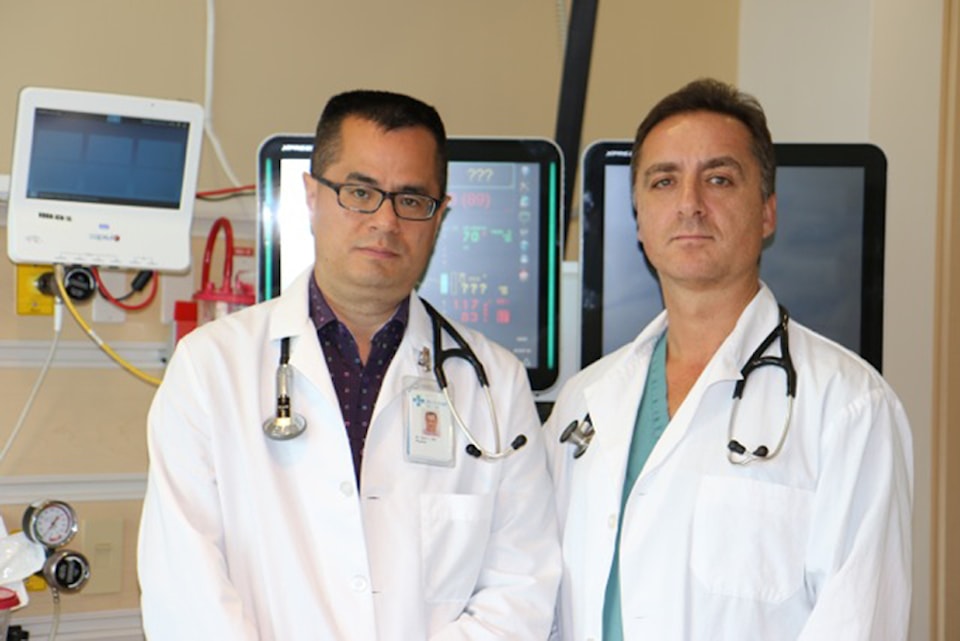A well-established life-saving treatment for heart attack victims that also reduces health care and other costs is not available in Red Deer.
Local doctors say they are fed up with Red Deer Regional Hospital Centre continually being overlooked for a cardiac catheterization lab. They are becoming activists for their patients over the issue and they want Central Albertans to join them in pushing for the service sooner rather than later.
On Sunday, the Facebook page, Central Alberta Needs Cardiac Catheterization, was launched and an online petition is also in the works, Dr. Kym Jim, head of Internal Medicine at Red Deer Regional Hospital Centre, said Monday.
Dr. Gustavo Nogareda, head of Cardiology at RDRHC who has done thousands of the procedures at other hospitals, said a local research project showed it could save about 30 lives each year, shorten hospital stays by two days, result in less heart damage therefore less medical care further on, and allow people to continue on with their lives and be productive.
Nogareda said having a “cardiac cath lab” in Red Deer would save health care costs of $3.5 million annually.
On top of this, Robert Bilton, chair of the Red Deer Regional Hospital Foundation, said the foundation can provide $10 million toward the lab’s capital cost. Local philanthropists Joan and Jack Donald have already offered a $5-million donation and the hospital foundation can provide another $5 million.
“I don’t know how much people in Central Alberta and Red Deer realize how much they’re getting short-changed with their services,” Jim said.
While the focus now is on a cardiac catheterization lab issue, what it comes down to is that Central Alberta and Red Deer need a tertiary care hospital that offers advanced services locally. “They need it in cardiology because more people are dying. … They need it in surgery because our surgical wait times are longer and people have to travel outside of this area to get services where they should be available locally.
“The services that we don’t have here are appalling in terms of what we should have,” Jim said.
“People’s tax dollars are leaving this community to support services in Edmonton or Calgary that could be supporting the local community.”
Red Deer hospital has the fourth highest amount of acute care cases in Alberta but it is not funded as such, Jim said.
Nogareda said that the mortality rates of heart attack victims in Red Deer that don’t have quick access to cardiac catheterization is 100 per cent higher the past couple of months compared with Edmonton and Calgary.
Treatment of a heart attack victim is very time sensitive, he said. When an artery can be opened in the first couple of hours by way of catheterization, damage can be minimal or negligible. More than three hours before the treatment results in significant damage to the heart and sometimes death.
Central Alberta heart attack victims are currently given medications that break down clots before they are transferred to Calgary or Edmonton by ground or air ambulance — considered an inferior treatment.
Cardiac catheterization involves inserting a catheter into the heart and opening up blockages with a balloon. Then in most cases a stent is inserted to keep the valve open, Nogareda said.
A catheterization lab at RDRHC would save lives and money, but also he argues the capital budget is already available because it is being spent on Central Alberta patients being sent to Calgary and Edmonton for treatment. Because of the time involved in transferring patients, the outcomes are poorer.
“We are going to spend less to achieve better outcome,” he said, adding it is “deeply” frustrating especially when facing people who are dying. Medical staff at RDRHC have the expertise to perform the procedure, he said.
Three years ago, 1,800 local cases were being treated in Edmonton or Calgary but the number now is probably closer to 2,000, Nogareda said.
Dr. Ted Braun, Alberta Health Services vice president and medical director for Central and Southern Alberta zones, said a recently released feasibility study on establishing advanced cardiac services at RDRCH determined it was feasible but also outlined a considerable amount of work needed to be done.
He said it would be premature to provide any time-lines or costs since the planning is just getting started, but he expects by spring they would have better understanding of what they would be.
The cardiac catheterization lab needs to be considered within the context of other components such as the appropriate number of beds, intensive care and recovery areas, and cardiac rehabilitation programs, Braun said.
A cardiac science director has been recruited and will be working with a local cardiologist to do the planning, which will take place in the context of larger, broader service planning for Red Deer and Central Alberta, he said.
Bilton, Jim and other local representatives will meet with Alberta Health Minister Sarah Hoffman next week about the need for a catheterization lab.
“People are dying because of this,” Bilton said. A long-time employee of his, in his 40s with a wife and two young children, died three years ago in Red Deer after a heart attack. Transferring him to Calgary or Edmonton for treatment would have taken too long and he would not have survived.
“People in Edmonton and Calgary seem to get the ear of the government before we do, regardless of what government it is,” Bilton said.
